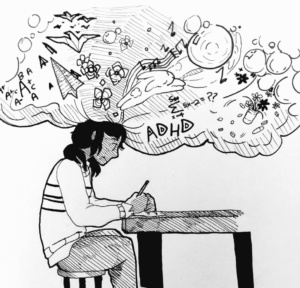Attention Deficit Hyperactive Disorder (ADHD)

Attention Deficit Hyperactive Disorder involves a persistent and frequent pattern of developmentally inappropriate inattention and impulsivity ,with or without hyperactivity ‘DSM-IV’.A child without hyperactivity has attention deficit disorder and a child with hyperactivity has attention deficit disorder. Both are implicated in learning disorders and can influence the behavior of a child at any, except cognitive level, except for moderate to profound mental retardation.
The cause is unknown. Several theories like biomechanical, sensor motor, physiologic and behavioral correlates and manifestation have been proposed.
Criteria for Attention Deficits and Hyperactivity Disorder:
- The child fails to give close attention to details or makes careless mistakes in schoolwork, work or other activities.
- Child has difficulty sustaining attention in tasks or play activities.
- Often does not seem to listen when spoken to directly.
- Does not follow instructions, and fails to finish schoolwork.
- Often easily distracted by extraneous stimuli.
- Often fidgets with hands or feet or squirms in seat.
The child with hyperactive disorder may have problem with sensory modulation and may be unable to inhibit or screen out touch sensation, unwilling to participate in school or home activities and inflexible in order to control the touch input received from the environment. Some children may experience poor tactile discrimination .
some children who are under responsive to touch may have delayed reaction to touch. For explains from a cut or a burn may be felt hours after it has occurred and not at the time it happened.
The child with hyperactive may have problem with vestibular system which provides information about movement, gravity and changing head position.
The vestibular system has an important influence in the development of eye movement, including tracking and focusing. The vestibular or visual system together help the body maintain an upright postures.
slow rocking ,linear motion ,and repetitive ,rhythmic movements have a calming effect on the nervous system and can decrease hyper reactive response to sensory input.
The child with hyperactive may have problem with proprioception which provides awareness of body position. It tells about the position of our body parts,and their relation to other people or objects .
which is related to muscle ,tendons,ligaments,joint capsule and connective tissue. The proprioceptive sensations are provided through activities that includes play wrestling, playing tug of war ,hitting punching bags, pulling heavy wagons and chewing crunchy foods. Some children cannot position their body correctly to get on a bicycle or step on an escalator. Some child may find it difficult to change their body position in response to the demands of the activity.
When playing ball ,it may be difficult for some children to move right or left or up high to catch a ball coming from different places. Written work can be messy .
The Wilbarger protocol using the technique providing deep pressure to the skin on the arms,back,and legs through the use of a special surgical brush, gentle compression are provided to the shoulder, elbow, wrist,finger,hip,knees ankle and sternum.
- TACTILE ACTIVITIES-Give high fives and push fives through out the day., draw in sand or salt, give, hand massage, participate in wheel barrow walking over various floor surfaces, give the child fidget toys to hold quietly while listening.
- CALMING TECHNIQUES-Provide a warm or tepid bath, perform joint compression, give deep pressure massage, backrub using comfort touch, perform slow swinging –back and forth-in a blanket, provide a weighted vest or collar, encouraging sucking, give firm pressure and skin to skin contact, perform progressive muscle relaxation. Encouraging fine motor and gross motor skill etc.
For more details contact us on 📞9618906780
